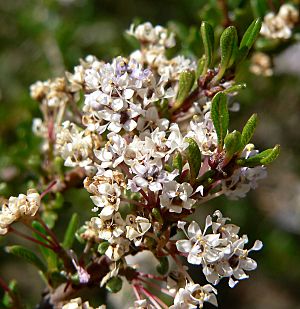Vail Lake ceanothus facts for kids
Quick facts for kids Vail Lake ceanothus |
|
|---|---|
 |
|
| Conservation status | |
| Scientific classification | |
| Genus: |
Ceanothus
|
| Species: |
ophiochilus
|
Ceanothus ophiochilus is a special kind of flowering shrub that grows only in a small part of Southern California. It's also known as the Vail Lake ceanothus. Scientists only officially described this plant in 1991, making it a relatively new discovery!
Where This Plant Lives
The Vail Lake ceanothus is a plant that is endemic to California. This means it naturally grows only in California and nowhere else in the world. You can find it in just a few spots near Vail Lake and the Black Hills. These areas are east of Temecula and west of the Santa Rosa Mountains in southwestern Riverside County.
This plant lives in a type of plant community called chaparral. In its small native area, which is only a few acres, it grows in a special kind of soil called pyroxenite. This soil is found on top of an ancient volcano. The plant grows at elevations between 580 and 1065 meters (about 1,900 to 3,500 feet).
The Vail Lake ceanothus is a very rare plant. It was listed as a threatened species by the United States government in 1998. The state of California called it an endangered species in 1994. This means it is at risk of disappearing forever. There are about 9,000 of these plants left. However, some of them are hybrids, meaning they are mixed with another type of Ceanothus crassifolius.
What It Looks Like
The Ceanothus ophiochilus is an upright shrub. It can grow up to 2 meters (about 6.5 feet) tall, but it is usually shorter. Its young branches are reddish. As they get older, they turn gray.
The plant has tiny evergreen leaves. They grow opposite each other on the branches. Sometimes, they grow in small groups. The leaves are usually less than a centimeter long. They are thick, firm, and shiny.
The shrub blooms in February and March. It has short groups of flowers called inflorescences. The flowers can be pale blue, white, or light pink.
How It Grows After Fire
This special plant grows only from seeds. This is different from many other Ceanothus plants. Most other Ceanothus plants have a special way to survive wildfires. They can grow back from their roots, which are called lignotubers, even after the top part of the plant burns. This is part of their natural fire ecology. But the Vail Lake ceanothus relies only on its seeds to regrow after a fire.
Growing This Plant
Ceanothus ophiochilus is grown by California native plant botanic gardens and plant nurseries. You can buy it as an ornamental plant for your garden. It is great for drought tolerant gardens because it doesn't need much water. It's also used in native plant gardens and natural landscape projects. These projects help create habitat gardens for local wildlife.


